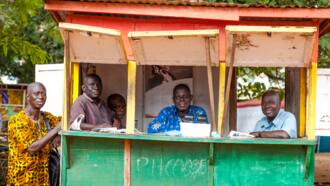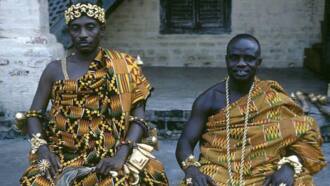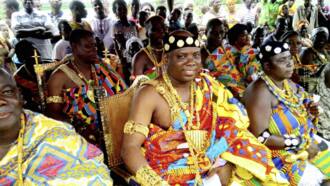Dagomba tribe: history, food, language, traditional dress, dance, facts
Ghana has more than 70 ethnic groups or tribes that occupy an area of 238,535 square kilometres. One of those ethnic groups is the Dagomba tribe found in the Northern Region of the country, where they are the most dominant ethnic group. The Dagombas share a rich history of oral traditions woven around drums and musical instruments. They have a culture that heavily relies on the teachings of the Koran and Islam in general.
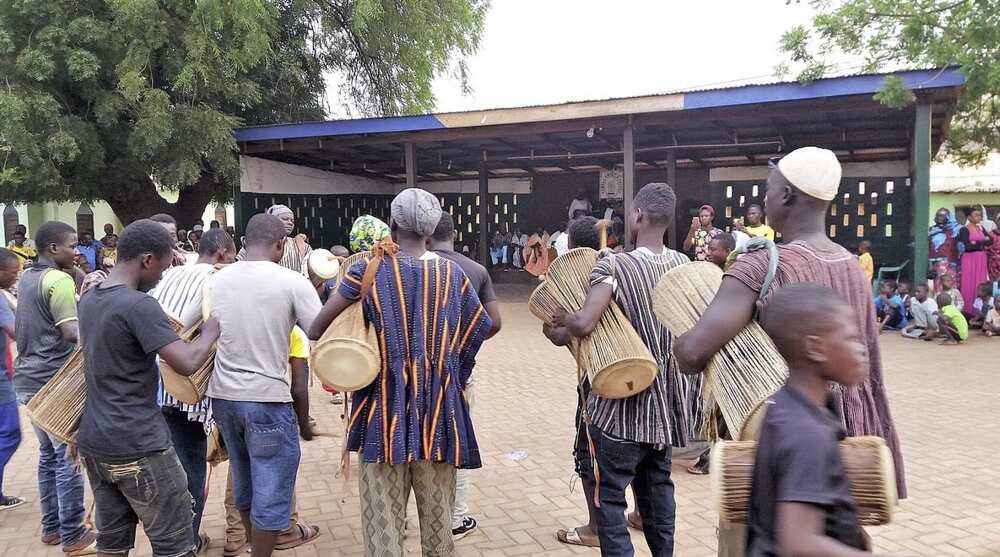
Source: UGC
The Dagomba people speak the Dagbani language. Dagbani language is part of the More-Dagbani subgroup of the Gur languages spoken in various West African regions, including Burkina Faso, Mali, Ivory Coast, Togo, Niger, Nigeria, and Benin.
Traditionally, the Dagomba tribe practised farming and animal breeding. They have a social organisation governed by chiefs and occupy the Dagomba Kingdom.
What does Dagomba mean?
Dagomba refers to the people located in the Northern territories of Ghana. They possess a common language known as Dagbani, which is a Gur language. Around 1.16 million people speak the language, which is also compulsory in primary and junior high school in the Dagbon Kingdom.
The word Dagbani refers to the language of the Dagomba people. Some terms are similar to what you will find in the Dagomba language. An example is Dagbani. It relates to the life and culture of the Dagomba people, and it means blessings.
History of the Dagomba tribe
The Dagombas migrated to their present occupancy from Lake Chad in the 13th century. They settled in a small village where they experienced drought, and the only source of water was a river known today as the Black Volta River.
READ ALSO: Kusaal: basic phrases and interesting facts
As a people, the Dagombas were farmers. It was an activity that men did while women helped during the harvests. Furthermore, the people were livestock breeders and kept cattle, chickens, sheep, goats, and guinea fowl. Despite living in a desert, they also practised hunting and fishing.
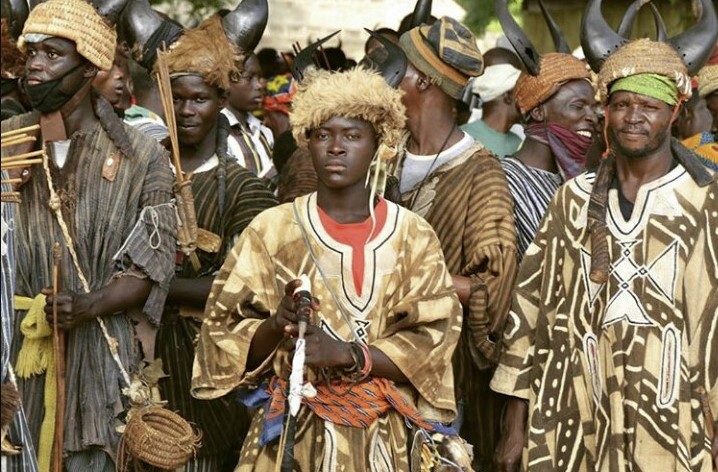
Source: UGC
The Dagombas lived and continue to live in the Dagbon Kingdom. It was a union of several political villages ruled by a King.
The king had absolute power, which the people called ya-na or Yaa Naa. Ya-na is a term that means king of strength and came into existence in the late 1300s. Since then, and even today, the people use it as a tree of the monarchs of the traditional Dagbon Kingdom.
Who founded the Dagomba Kingdom?
The Kingdom of Dagomba is an old and organised traditional Kingdom founded by the Dagomba people in the 11th century. It covered an area of about 20,000 square kilometres and was once home to the Konkombas, a Gur ethnic group found in Eastern and Greater Accra Regions of Ghana.
The Dagomba oral traditions state that northern invaders founded the Kingdom in the 14th century. A warrior named Tohazie or red hunter and his cavalrymen engaged in numerous conflicts with neighbouring communities and won wars that enabled them to establish and control the Kingdom.
READ ALSO: Ashanti culture, language, religion, food, rites, clothing, facts
Tohazie migrated from the North-East of Lake Chad to the South of the Niger bend known as Zamfrara. Zamfara is modern-day Nigeria.
Initially, the Dagombas used to trade kola nuts, slaves, gold, and textiles with the Hausa and Ashanti kingdoms. But around the 17th century, the Ashanti subdued the Dagomba kingdom, reduced the size of their land, and forced them to pay annual tributes in the form of slaves.
Dagomba culture and traditions
The Dagombas have an elaborate system of oral traditions. They pass their history from one generation to another through word of mouth. Traditionally, the people had a social organisation governed by chiefs.
It is customary for the leader to sit on a pile of skins made in the form of a royal stool called Gbolon. Also, the person given the power and authority to lead the people does not have a throne.
Before an individual can become a Yaa Naa, the elders adorn him with the royal insignia. It consists of a hat that once belonged to Tohadzie and a smock. He also gets a calabash, beads, gourd, and several spears.
Dagomba traditional dance

Source: UGC
Like many other tribes in Ghana, the Dagomba have a robust and intricate musical tradition. Through their music, they have been able to pass their oral traditions from one generation to another, thus preserving their origins and history. The Dagombas achieve this through dance-drumming.
Dance-drumming in the Dagomba culture tells the stories of significant events in their history. Music has played significant roles in their festivals and periodic lives. It is through the dance that they remind themselves where they came from, their identity, and the values they hold.
Generally, the Dagomba have many music styles. The people compose music specifically to accompany or facilitate dancing. But it is the drumming that is central to the Dagomba dance because it represents a rich culture that they possess. Whenever they play the drums, they are making a musical sound and speaking words of wisdom.
READ ALSO: Mampruli: basic phrases and interesting facts
The ethnic group holds drummers in high esteem. They consider them storytellers and keepers of the Dagomba history.
The drummers understand the various relationships within their communities and can form songs of encouragement and teachings. Although today they embrace and incorporate modern music, traditional music and dancing are universal in congregations, formal gatherings, and other ceremonies.
Dagomba festivals
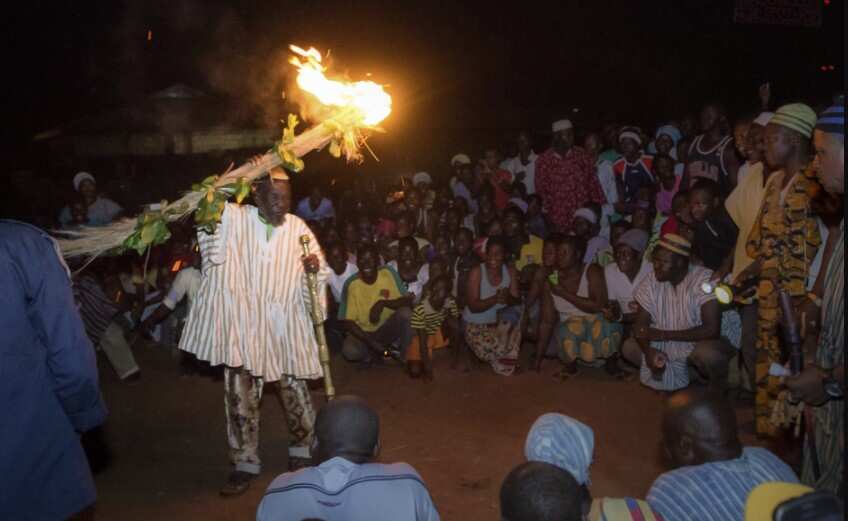
Source: UGC
Dagombas have many festivals throughout the year. But one that many parts of the world recognise is the Bugum Chugu or fire festival. Bugum Chugu is usually the first festival of the year in the Dagomba tribe. People celebrate it on the ninth day of the first month to remember the lost chief son.
According to the tribe’s oral traditions, the festival began many years ago when one of their kings lost his son. They searched for him through the night and found him sleeping below a tree.
The ruling king at that time thought the tree had hidden his son because they looked for him throughout the day. He then declared the tree evil. Since the warriors had lit torches to look for the boy, the king took it and torched the tree.
READ ALSO: Ga-Adangbe tribe: language, traditional wear, dances, food, religion
Later, he called the community to burn it and ordered them to commemorate the event every year. Whenever the Dagombas march to the evil tree, they play and dance for the tindaamba or land priests. Even today, some of them dress as warriors during this festive.
Another one of the many Dagomba festivals is the Damba. The Damba is a festival celebrated by the chiefs and people during the Dagomba lunar month of Damba. It corresponds to the third month of the Islamic calendar known as Rabia al-Awwal.
They celebrate it to mark the birth and naming of Prophet Muhammad. However, its content tends to glorify the chieftaincy and not Islamic motifs.
Dagomba traditional dress
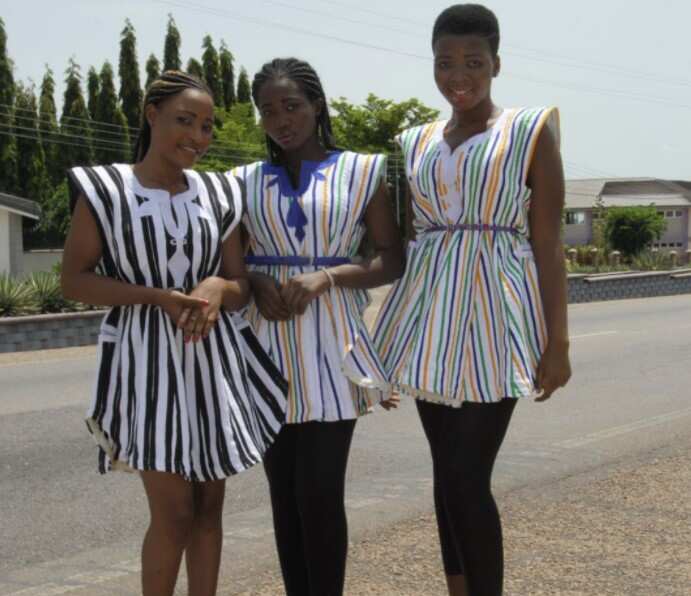
Source: UGC
The Dagomba traditional dress is known as the smock. Before they started wearing the smock, they used to dress in animal skins. But after the introduction of trade networks, they started wearing clothes, and this is where they invented the smock.
The smoke is a fabric made from cotton. Traditionally, it is the women that process it into threads. They then stretch and dye the threads into different colours. The men then come in wove the yarns into strips on handlooms.
Each strip is four inches wide, which they sew together and make the smock. Women of the tribe wear a locally made cloth called Bin maŋli. They wear it on special occasions, including festivals, funerals, and weddings, among others.
READ ALSO: Positive and negative cultural practices in Ghana
Other types of clothes worn by the Dagomba include:
- Biŋma
- Dansichi
- Kparigu
- Kpaakuto
- Yԑbli
- Kparmasu
- Biŋma bohri
Each of these clothes has a unique history in the culture of the Dagombas.
Dagomba food
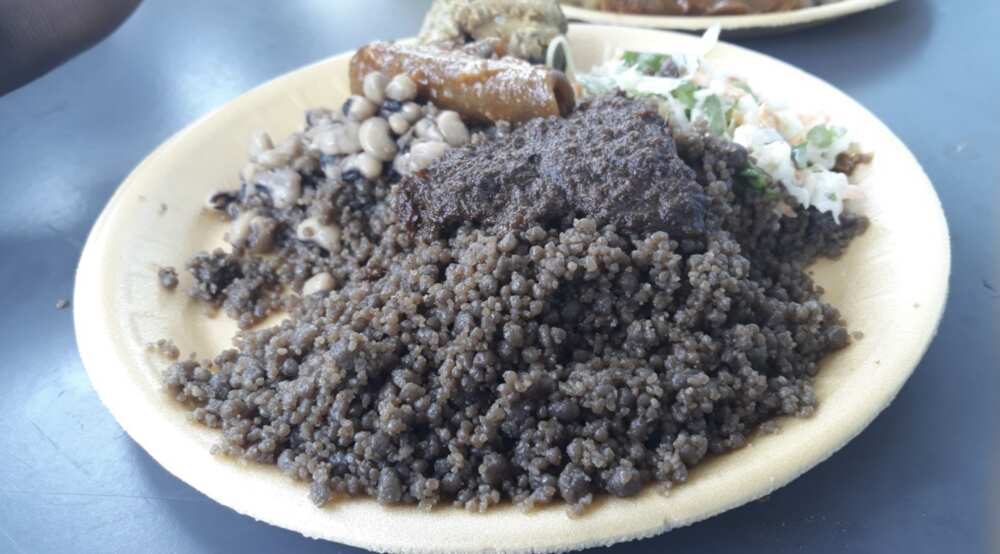
Source: UGC
The Dagombas have a unique type of food known as Wasawasa. It is a dish made from dried yam leaves that the people grind into flour and then steamed. When serving the food, they eat it with spicy or garnish it with some vegetables. In other cases, they accompany the cuisine with raw groundnut oil and fried fish or served with sliced onions and shea butter oil.
Apart from being a traditional food, it is healthy food and provides lots of nutritional benefits. That is because of the various ingredients used to make it, including yam flour, freshly ground pepper, salt, onions, groundnut, or shea butter oil. They also use water for steaming.
READ ALSO: Guan tribe: history, language, food, dance, festivals, and facts
Dagomba religion
Islam is the religion that influences the Dagomba people. Islam has grown tremendously among the ethnic group. According to oral traditions, the Soninke brought it to the region in the 12th and 15th centuries. Islam has also been the state religion since the reigns of Naa Zangina.
The Dagomba tribe is an ethnic group found in the northern regions of Ghana. People in this area speak Dagbani, which is a language that is part of the Gur Languages. Oral traditions state that Tohazie founded the Dagomba Kingdom in the 12th century. Dagombas pass their culture orally from one generation to the other. The people are Muslims, and Islam is the religion that influences their culture, traditions, and daily lives.
Yen.com.gh has created a list of all ethnic groups in Ghana and where they are found. The list covers both the large tribes and smaller ones.
Ghana has a diverse culture thanks to over 100 ethnic groups that call the country home. While each group holds its values dear, modern Ghanaians cut across different cultures due to urbanisation and intermarriages.
Source: YEN.com.gh



